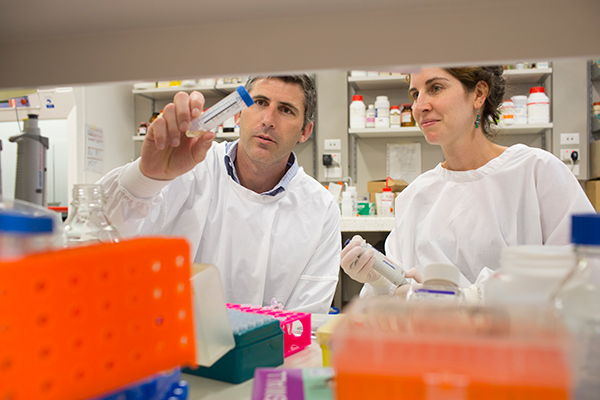February 18, 2014
New target identified in fight against Motor Neurone Disease
Researchers publish important paper on the cause and spread of Motor Neurone Disease.

A three-way collaboration between health and medical researchers in ÁñÁ«ÊÓƵapp, Melbourne and Canada has resulted in the publication of an important paper on the cause and spread of Motor Neurone Disease; an incurable and fatal neuromuscular condition for which there is only one approved medication in Australia.
The paper, , reveals an explanation for the observation that the symptoms of MND (or Amyotrophic Lateral Sclerosis) are progressive and seem to move in an ordered way from region to region in the brain and spinal cord.
“MND is like a fire starting in one neuron and then spreading from cell to cell,” explains one of the paper’s lead scientists, (pictured above left), from the , based on the ÁñÁ«ÊÓƵapp of ÁñÁ«ÊÓƵapp campus.
“We have uncovered what we think is the ‘fire’ - misfolded proteins [SOD1] which can jump from cell to cell, moving outside neurons before being up taken by nearby cells. This process can also be compared to an infection, which can be passed from cell to cell.”
While it is unlikely that MND is infectious, the discovery that misfolded “wild-type” SOD1 can be transmitted from cell to cell, and that propagated protein misfolding can be perpetuated, was made when the researchers focused on the similarities between MND and prion diseases such as Mad Cow Disease and Creutzfeldt–Jakob Disease, which are also fatal.
“The form of the protein that causes neurons to die in prion diseases is very hardy, very stable and very hard to get rid of,” explains Dr Yerbury, who received an Australian Research Council Discovery Early Career Research Award in 2012 and has previously received a Motor Neurone Disease Australia Bill Gole Fellowship.
“The form of protein that we are looking at is more sensitive than its original form and is therefore more susceptible to being removed or degraded. Our hypothesis is that this process is not going to go from person to person, but rather from neurone to neurone.”
While other research groups have been studying propagated protein aggregation, the researchers were among the first to make the link between prion-like mechanisms and MND.
“While they sound very different, prion-like mechanisms have, increasingly, been implicated in other neurodegenerative and systemic disorders,” says Dr Yerbury, who initiated the collaboration three years ago after hearing Professor Neil Cashman, from the ÁñÁ«ÊÓƵapp of British Columbia and Vancouver Coastal Health Research Institute, talk at an MND conference.
“Professor Cashman had data suggesting that the proteins could jump from one cell to another, while we had information about the mechanisms involved,” he explains.
“Dr Brad Turner, at the ÁñÁ«ÊÓƵapp of Melbourne, became involved after he proposed that proteins can jump from cell to cell while the cells remain alive, whereas our research proposes that they can still manage to do this, even after they have died. This two-pronged approach strengthens our argument and, after many revisions, we are thrilled to have our work published in such a prestigious journal.”
The research also proposes that the misfolded SOD1 may be responsible for both sporadic and familial cases of MND (90 to 95 per cent of cases are sporadic, with the remaining five to 10 per cent of cases being familial), which represents another breakthrough.
MND currently afflicts as many as 1 in 350 males and 420 females over the age of 18. Half of affected individuals die within three years and less than 20 per cent survive for more than five years.
Dr Yerbury says that the research represents another step in finding a target for much- needed treatments.
“From here we will be looking more specifically at the uptake mechanism and the possibility of stopping the uptake with drugs. We imagine this to be similar to HIV drugs, which don’t kill the virus but stop it going into next round of cells.”
Media contacts: Dr Yerbury is available for interview on + 61 2 4298 1534, +61425 282 734 or jyerbury@uow.edu.au. For more information, contact IHMRI Communications Coordinator, Robyn Gower, +61 2 4252 8228 or rgower@uow.edu.au.